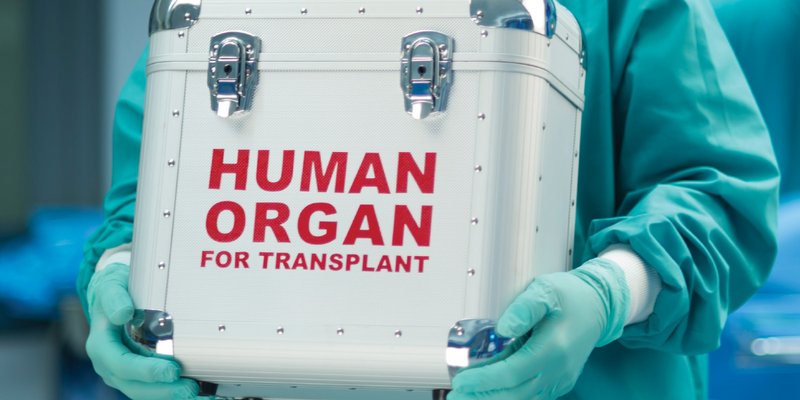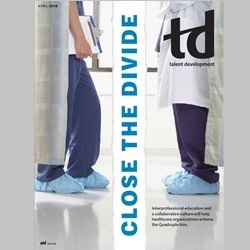TD Magazine Article
Better Communication Skills Can Save Lives
Training healthcare staff to have organ-donation conversations with patients and their families can increase the donor pool.
Mon Apr 01 2019

Bookmark
Training healthcare staff to have organ donation conversations with patients and their families can increase the donor pool.
Worldwide, the need for more organ donors is a critical public health issue, and talent development professionals can help address it.
According to Gift of Life Donor Program, the largest organ procurement organization (OPO) in the United States, there are "approximately 114,000 men, women, and children awaiting a life-saving transplant in the U.S.," and every 10 minutes another person is added to the waiting list. One organ donor can save up to eight lives, and one tissue donor can benefit more than 75 people. However, every day nearly 20 people in the United States die while on the transplant waiting list. Globally, the number is much higher.
The problem is complex and multidimensional, but there is a significant gap that defines it: The number of people who say they support organ donation is significantly greater than the number who register as organ donors. The U.S. Department of Health and Human Services' Health Resources and Services Administration reports that 95 percent of the U.S. adult population support organ donation but only 54 percent have registered to become organ donors.
There is no single solution to address the issue, but there are practical initiatives and programs that talent development professionals can implement that can help.
One family's story
Greg Howell needed a new heart and was on the donor list for four months. His wife Cyndy shared their story:
"We got 'the call' on Monday, January 7, 2013. It was 3:38 p.m. Greg was at the post office. I was sitting in the pickup line at our granddaughter's school when the call came. When I answered, they asked for Greg. They said that they had been trying to get hold of him but that he wasn't answering his phone. I told them that he was at the post office and probably left the phone in the truck.
"The woman on the phone said, 'We need to get in touch with him. We have a heart.' ... I could hear her smiling on the phone. 'We have a heart. We need him to get to Vanderbilt as soon as possible.' ...
"Once you get on the waiting list you have a 'go bag' ready. We both pulled in the driveway at the same time, grabbed our bags and left. Greg received his heart at 6:30 a.m., January 8, 2013. He celebrated his 60th birthday eight days later in the hospital. ... We're so very blessed."
A culture of donation
"I am constantly astounded by the selfless generosity of donor families," says Dr. Diane Alonso, medical director of the Transplant Service at Intermountain Healthcare in Utah. As a transplant surgeon, she has witnessed patients rescued from the jaws of death because they received an organ donation.
Alonso and others interviewed for this article are relentless champions for organ donation. "The reality is, education around organ donation will never end," she says, noting there is room for improvement at every level.
Jennifer Milton, executive director at University Transplant Center in Texas, agrees. In addition to the broader effort of increasing awareness about organ donation and driving more donor registrations, she believes hospital systems need to constantly evaluate the policies and procedures related to end-of-life care and organ donation. Among her recommendations is using the informed consent process for organ donation conversations.
"We can increase awareness by having end-of-life discussions before we're in end-of-life situations," Milton says. By looking at organ donation through the informed consent lens, Milton believes hospital procedures related to end-of-life care and organ donation could be handled as a "quality improvement opportunity." Further, treating as "sentinel events" those missed opportunities to act on first-person authorization of organ donors would incentivize hospitals to discover more and better ways to drive awareness for the importance of organ donation systemwide, help create a culture of donation within the hospital, and save more lives.
This is an area for talent development professionals to consider. Under the umbrella of continuum of care and saving more lives, an analysis of the policies and procedures related to end-of-life care and organ donation could reveal ripe opportunities to create programs that address performance improvement. In addition to specific training related to caring for and communicating with patients and families who are facing end-of-life situations, talent development professionals can also consider creating programs that address these issues earlier in the patient experience—for example when patients are checking into the hospital for care. Such proactive approaches could help create a culture of donation at a hospital.
Education and awareness are key. Even within hospitals, it is common for healthcare staff not involved with the transplant process to be unaware of or uneducated about organ donation, Alonso notes. At Intermountain Healthcare, cultivating a culture of donation has taken years, but now the end-of-life discussions that include conversations about organ donation are "another spectrum of how we care for our patients," Alonso explains.
Policies, procedures, and communication skills
Part of what makes the organ donation component of end-of-life care so complex is the network of professionals and organizations that need to communicate and collaborate in an emotionally charged and time-sensitive environment. In the United States, any hospital that receives Medicare funding must be associated with an OPO. Each OPO serves a network of hospitals in its region. It is the OPO's responsibility to initiate and lead conversations with potential donors and donor families and then coordinate the donation of organs or tissue to waiting patients once a donor is deceased.
OPOs often help hospitals set up policies, procedures, and protocols that deal specifically with end-of-life and organ donation scenarios, and some even help hospitals with their accreditations.
Gift of Life Institute, an affiliate of Gift of Life Donor Program, is an international provider of organ and tissue donation education and has trained close to 9,500 professionals from 39 countries since 2004. Patricia Mulvania, a senior faculty member of Gift of Life Institute, says its OPO and many others meet proactively with hospitals to put processes in place so that organ donation becomes part of the hospital's culture.
Training is paramount, and communication skills training is critical to success. Empowering OPO and healthcare staff with the resources and knowledge of how to best communicate with families during emotionally wrenching times is crucial.
Gift of Life offers courses focused specifically on family communication and leading effective organ and tissue donation conversations. A two-day in-person training, offered twice yearly, builds on foundational knowledge of the Dual Advocacy model (which addresses the needs of both donor families and patients waiting for organs) and examines how the framework can be combined with advanced communication skills to help families navigate crisis situations. A five-week virtual training course is also offered; it introduces the skills and knowledge required to provide timely, compassionate, and informed donation opportunities across commonly encountered, straightforward, and challenging situations. The virtual course combines e-learning modules, instructor-led webinars, discussion boards, assignments, and assessments.
Mulvania believes an area of opportunity for improving rates of organ donation centers on communication skills. "If I could give staff a superpower, it would be communication," she states.
Initial and ongoing simulation-based practice of communicating with families for OPO and healthcare staff can help ensure those stakeholders are prepared when the moment for powerful end-of-life and donation conversations must take place, Mulvania explains. Special considerations include situations where a patient is identified as an organ donor but family members do not give consent for donation or when cultural or religious beliefs affect a donation decision.
"We have the responsibility to help people find meaning in the act of donation," Mulvania adds. "There's something about what we say and how it's said that helps people decide" to donate. Research concurs. Articles in several medical journals show that conversations that communicate support, understanding, and positivity about donation can positively influence authorization rates.
The importance of communication skills in end-of-life training is evidenced by the update to curriculum for nurses, who are crucial players in end-of-life care. The End of Life Nursing Education Consortium (ELNEC) now includes a focus on communication skills in its curriculum.
An experienced nurse educator, Mary E. Holtschneider is co-director of the Simulation Fellowship at the Durham Veterans Affairs Health Care System in North Carolina and nursing program manager at Duke Area Health Education Center. She says she was excited to see ELNEC's focus on communication skills and believes hospitals should be creating programs that prepare staff to meet the challenge of caring for patients and families who are facing end-of-life decisions.
"Naturally, excellent communication skills with patients and family members are essential to help them move through this transition time. Nationally recognized educational programs, such as ELNEC, can help nurses and other team members develop a shared mental model on how to optimally care for these patients and their families," says Holtschneider.
Role play is another effective training method. "Healthcare simulation educators and others in training and development can design and develop high-fidelity simulations that use ‘standardized patients' \[trained medical actors\], who help healthcare professionals practice and hone these skills," Holtschneider explains. "They can portray patients, family members, and other healthcare team members facing a wide range of emotions and challenging behaviors. Simulation practice provides a safe environment for healthcare professionals to learn and practice important skills."
She adds, "It is important that the interprofessional healthcare team understand the many aspects of end-of-life care, including available resources, facility policies and procedures, potential therapeutic modalities, and symptom management."
Gweneth O'Shaughnessy, director of hospital services for Gift of Life Donor Program and faculty for Gift of Life Institute, agrees. Gift of Life supports its healthcare partners by providing extensive education, making sure they're prepared and comfortable in their roles in the donation process. Using meaningful data that help to characterize trends and areas for improvement is another component to improving donation rates. The institute also offers customized on-site OPO training courses that its faculty facilitates.
Regardless of a patient's donor status, hospitals "need to have protocols to protect the donation opportunity," O'Shaughnessy states. Her team works with healthcare partners to debrief cases and determine what worked, what didn't, and why. "We meet with CEOs of our hospitals every year and share data, transplant outcomes, and make recommendations for improvement," she says. "And we will ask the CEOs for access to all stakeholders who touch end-of-life care." High engagement with hospitals brings the necessary resources and support for those staff at the bedside caring for patients and families.
More decision points
Having more transactional touchpoints where people can choose to become a donor will help drive awareness and expand the potential donor pool. For example, Milton speculates about scenarios in hospitals where primary care doctors have organ donation discussions with patients during annual exams or, when as part of onboarding, hospital employees receive information about being an organ donor.
Other ideas could include HR departments in any industry using onboarding conversations about health benefits to drive organ donation awareness. Could open enrollment be an opportunity to create an awareness campaign about organ donation?
"Just one donor can save or enhance so many lives," Cyndy Howell notes. "The more information people have, the more acceptable it will become."

More from ATD



